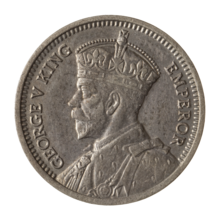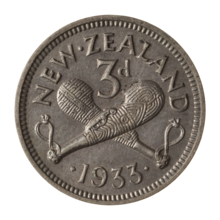
The British threepence piece, usually simply known as a threepence, thruppence, or thruppenny bit, was a denomination of sterling coinage worth 1⁄80 of one pound or 1⁄4 of one shilling. It was used in the United Kingdom, and earlier in Great Britain and England. Similar denominations were later used throughout the British Empire and Commonwealth countries, notably in Australia, New Zealand and South Africa.

The pound was the currency of Australia from 1910 until 14 February 1966, when it was replaced by the Australian dollar. Like other £sd currencies, it was subdivided into 20 shillings, each of 12 pence.
George Edward Kruger Gray was an English artist, best remembered for his designs of coinage and stained glass windows.

The threepence or 3d coin was a subdivision of the pre-decimal Irish pound, worth 1⁄80 of a pound or 1⁄4 of a shilling. Leath reul literally means "half reul", the reul being a sixpence coin worth about the same as the Spanish real. As with all other Irish coins, it resembled its British counterpart, as the Irish pound was pegged to the British pound until 1979.

The British sixpence piece, sometimes known as a tanner or sixpenny bit, was a denomination of sterling coinage worth 1⁄40 of one pound or half of one shilling. It was first minted in 1551, during the reign of Edward VI, and circulated until 1980. The coin was made from silver from its introduction in 1551 until 1947, and thereafter in cupronickel.
The threepence or threepenny bit was a denomination of currency used by various jurisdictions in England, Ireland, Scotland and Wales, valued at 1/80 of a pound or 1⁄4 of a shilling until decimalisation of the pound sterling and Irish pound in 1971. It was also used in some parts of the British Empire, notably Australia, New Zealand and South Africa.
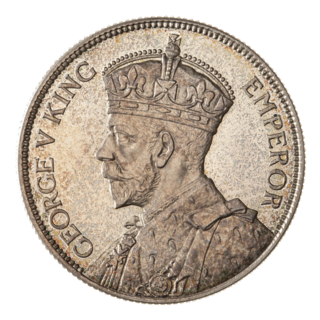
The florin is a coin issued for the New Zealand pound from 1933 to 1965, equal to two shillings or twenty-four pence. The coin features a kiwi on the reverse and the reigning monarch on the obverse. It was introduced in 1933 as part of the first issue of New Zealand pound coinage, due to shortages of British silver coins resulting from the devaluation of local currency relative to the pound sterling. A lengthy design process was further protracted due to differing proposed design motifs between the Royal Mint, supporting a reverse design featuring heraldic ships, and the Gordon Coates–appointed Coinage Committee's proposed kiwi design. This disagreement led to almost a dozen proposed designs and revisions before the finalised issue entered circulation in February 1934. Initially struck in silver by the Royal Mint to replace the previous imperial florin, it was struck in cupronickel from 1947 due to rising precious metal prices. While proposed as the base of a decimalised New Zealand coinage since the 1930s, the florin was ultimately replaced in 1967 by the coinage of the New Zealand dollar.
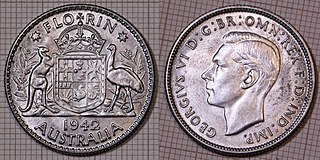
The Australian florin was a coin used in the Commonwealth of Australia before decimalisation in 1966. The florin was worth two shillings . The denomination was first minted in 1910 to the same size and weight as the British florin.

The shilling, informally called a "bob", was a type of silver coinage issued by the Commonwealth of Australia, that circulated prior to the decimalisation of Australian coinage. The Australian shilling was derived from the British pre-decimal sterling pound system and was first issued following the passing of the Australian Coinage Act 1909, which established Australia's first formal currency system. The shilling was issued as part of Australia's silver coinage, which included the two-shilling (florin), the sixpence and the threepence. The shilling was minted from 1910 until 1963. During this period there was one significant modification to the design of the Australian shilling, the change in its reverse design, which occurred in 1938 when the design was altered from the Australian Coat of Arms (1910–1936) to the visage of a Merino ram’s head (1938–1963).

The Jubilee coinage or Jubilee head coinage are British coins with an obverse featuring a depiction of Queen Victoria by Joseph Edgar Boehm. The design was placed on the silver and gold circulating coinage beginning in 1887, and on the Maundy coinage beginning in 1888. The depiction of Victoria wearing a crown that was seen as too small was widely mocked, and was replaced in 1893. The series saw the entire issuance of the double florin (1887–1890) and, in 1888, the last issue for circulation of the groat, or fourpence piece, although it was intended for use in British Guiana. No bronze coins were struck with the Jubilee design.
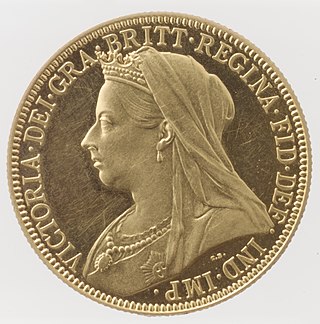
The Old Head coinage or Veiled Head coinage were British coins struck and dated between 1893 and 1901, which featured on the obverse a portrait by Thomas Brock of an aged Queen Victoria wearing a diadem partially hidden by a widow's veil. It replaced the Jubilee coinage, struck since 1887, which had been widely criticised both for the portrait of the Queen, and because the reverses of most of the coins did not state their monetary values. Some denominations continued with their old reverse designs, with Benedetto Pistrucci's design for the sovereign extended to the half sovereign. New designs for some of the silver coinage were inaugurated, created either by Brock or by Edward Poynter, and all denominations less than the crown, or five-shilling piece, stated their values.

The halfpenny was first issued in New Zealand in 1940, seven years after the first introduction of a domestic pound coinage. The coin's issuing was scheduled to align with the centennial of the Treaty of Waitangi and the New Zealand centennial, alongside the penny and centennial half-crown. Designed by Leonard Cornwall Mitchell after winning a government-sponsored design competition, the halfpenny features the head of the reigning monarch on the obverse, with a hei-tiki pedant ornamented with simplified kowhaiwhai woodcarvings on the reverse. The smallest of all denominations of the New Zealand pound, the copper coin was worth 1/480th of a pound, or 1/120th of a crown, the largest coinage denomination. It was discontinued alongside all other New Zealand currency following decimalisation in 1967.

The Waitangi crown is a commemorative crown coin struck in 1935 by the British Royal Mint for the Dominion of New Zealand to commemorate the 1840 signing of the Treaty of Waitangi, often seen as New Zealand's founding constitutional document. It was the first five-shilling piece minted of the New Zealand pound and the nation's first coin minted primarily for collectors. Following the rejection of designs by James Berry and George Kruger Gray, Royal Mint designer Percy Metcalfe was commissioned to design the reverse. Design disagreements plagued the production of the crown, and only an extremely small mintage of 1,128 was struck and distributed to collectors. Released to muted media coverage and a general lack of interest in coin collecting during the economic aftermath of the Great Depression, the coin has become heavily sought by collectors of New Zealand coinage. Regularly selling for thousands of dollars, one pattern issue of the coin auctioned at over $70,000 USD, becoming the most expensive New Zealand coin ever sold.
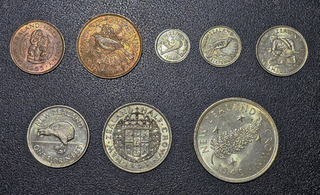
The first coinage of the New Zealand pound was introduced in 1933 in response to large-scale smuggling of prior British imperial coinage after devaluation of New Zealand exchange rates relative to the pound sterling and large influxes of other foreign coinage into circulation. The Coinage Act, 1933 outlined the weights and compositions of various denominations, out of which five silver issues entered circulation over the following year, after lengthy disagreement between rival coinage design committees. The copper penny and halfpenny entered circulation in 1940, corresponding to anniversary of the New Zealand centennial. An eighth denomination of coin, the five-shilling piece or crown, was produced solely through three commemorative issues. The first issue, the Waitangi crown, was produced in extremely limited quantities and sold to collectors. Later commemorative crown issues in 1949 and 1953 were produced for circulation.

The New Zealand penny is a large bronze coin issued from 1939 to 1965. Introduced seven years after the larger denominations of New Zealand pound coinage, the coin's issuing was scheduled to align with the centennial of the Treaty of Waitangi and the New Zealand centennial, alongside the halfpenny and centennial half-crown. Featuring the standard portrait of the ruling monarch on the obverse, the reverse features a tūī bird perched atop a kōwhai branch.

The New Zealand shilling was first issued in 1933 alongside four other denominations of New Zealand pound coinage, introduced due to shortages of comparable British silver coinage following the devaluation of the New Zealand pound relative to the pound sterling. Roughly 24 mm in diameter, it is slightly larger than the British coin it replaced. Worth twelve pence, the denomination was equal to half a florin, two sixpence, or two-fifths of a half-crown.

The New Zealand sixpence is a coin of the New Zealand pound issued from 1933 to 1965. Equal to twice a threepence or half a shilling, the sixpence was one of five denominations of silver coinage introduced in the initial issue of New Zealand coinage in 1933. Early designs for the coin featuring spears and silver ferns were rejected by committee. The coin's final reverse, designed by George Kruger Gray, features a female huia, an extinct New Zealand bird, perched atop a branch. Issued in 50% silver until a postwar rise in silver prices triggered a shift to cupronickel in 1947, the coin was minted with relative consistency until 1965, when it was discontinued following decimalisation and the adoption of the New Zealand dollar.

The half-crown is the largest of five denominations of New Zealand pound coinage first issued in 1933. Introduced due to shortages of comparable British silver coinage following the devaluation of the New Zealand pound relative to the pound sterling, the coin measures roughly 32 mm (1.3 in) in diameter. It was equal to thirty pence, two and a half shillings, or an eighth of a pound.

The Centennial half-crown is a commemorative coin of the New Zealand half-crown released in 1940 to coincide with the hundredth anniversary of the Treaty of Waitangi. Designed by New Zealand artist Leonard Cornwall Mitchell, the coin features a Māori woman surrounded by both traditional and modern architecture. Although a relatively large number, over a hundred thousand, were issued, the coin was obtainable at face value and quickly disappeared from circulation.

A commemorative crown coin of the New Zealand pound was produced for a planned visit by King George VI in 1949. Having first visited the country in 1927 in his duties as the Duke of York, proposals for a visit by the monarch to New Zealand in 1940 were postponed by the outbreak of World War II. A 1949 tour by the king and queen to Australia and New Zealand was announced in early 1948, the first visit of a reigning monarch to the dominion.
